#Gaza demonstrations
Text
During her speech before demonstrators in New York, author and journalist Naomi Klein condemned Israel's crimes against Palestinians, asserting that Zionism has strayed from Jewish values and stating, "Zionism is a false idol that has betrayed every Jewish value."
“We don’t need or want the false idol of Zionism. We want freedom from the project that commits genocide in our name,” she added.
The demonstration, held just one block from the residence of US Senate Majority Leader Chuck Schumer, resulted in the arrest of hundreds of protesters. This event coincided with the Senate's approval of a $95 billion foreign aid package, which includes approximately $17 billion in arms and security funding for Israel.
#palestine#free palestine#gaza#free gaza#israel#israel is a terrorist state#i stand with palestine#genocide#jerusalem#israel is evil#During her speech before demonstrators in New York#author and journalist Naomi Klein condemned Israel's crimes against Palestinians
3K notes
·
View notes
Text
🇯🇴🇵🇸 🚨
JORDANIANS DEMONSTRATE FOR GAZA OVER AN ENTIRE NIGHT IN AMMAN
📹 Thousands of demonstrators out rallying in support for Gaza and in solidarity with Palestinians in Amman, the Jordanian capital, which went on until dawn today.
#source
@WorkerSolidarityNews
#jordan#jordan news#solidarity with palestine#demonstrations#protests#pro palestine#pro palestine protest#potest#israel palestine conflict#gaza#gaza strip#palestine#palestine news#palestinians#israel#israel news#politics#news#geopolitics#world news#global news#international news#war#breaking news#current events#war on gaza#free palestine#free gaza#gaza news#jordanians
950 notes
·
View notes
Text
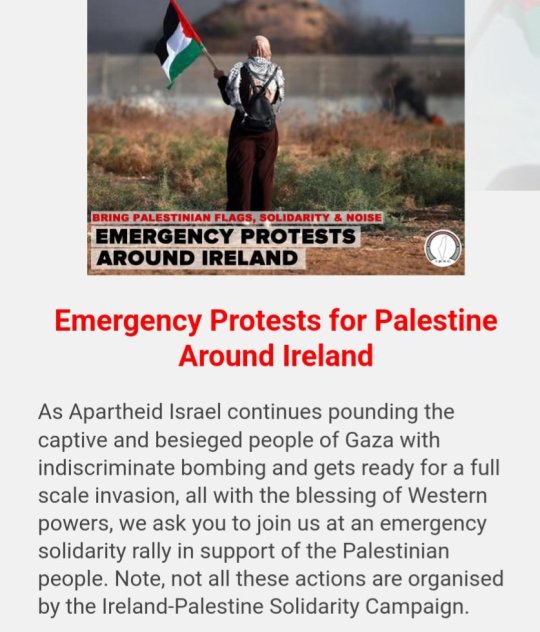

Here's the protests arranged for the weekend, show solidarity with Palestine
🇵🇸✊🇮🇪
#free gaza#free palestine#gaza strip#irish solidarity with palestine#palestine#gaza#news on gaza#al jazeera#boycott israel#israel#Protest#Ireland#irish tumblr#Demonstration#Dublin#CORK#SLIGO#Belfast#Limerick#Derry#Drogheda#Nenagh#TRALEE#Ballincollig
1K notes
·
View notes
Text
Arresting Liberty
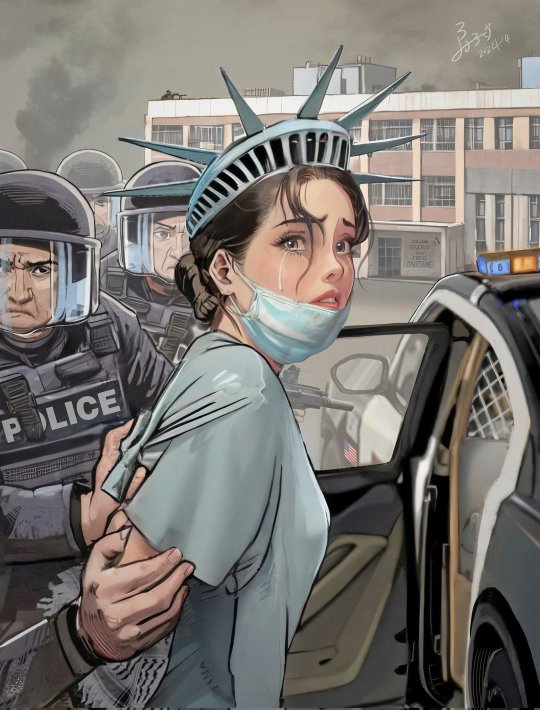
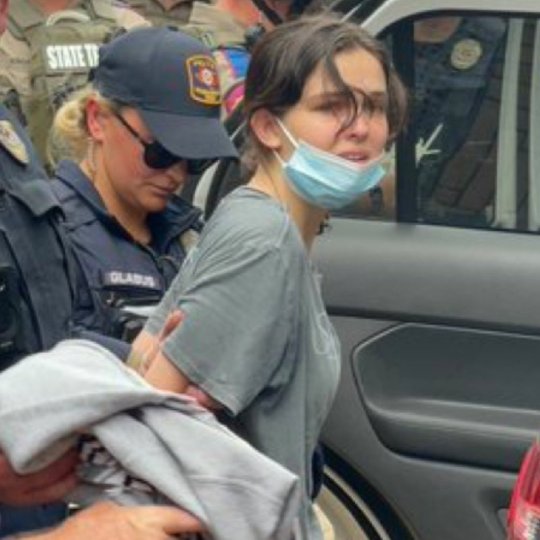
#photography#art#gaza#palestine#palestinians#free palestine#israel#islam#islamophobia#liberty#rights#freedom#civil rights#free gaza#free speech#liberation#freedom of speech#freedom of expression#freedom of the press#police state#protest#columbia university#student protests#aaron bushnell#activism#demonstration#demonstrators#war crimes#war criminals#crimes against humanity
122 notes
·
View notes
Text



-From river to the sea, Palestine will be free!🇵🇸
Draw your fav character with a watermelon to show that we all are with them! :D🍉✨
#ik I'm late but- actually.. It's never too late to say and demonstrate that I want palestine to be free!💖#ceasfire now#ceasefire#from the river to the sea palestine will be free#from river to sea palestine will be free#free palestine#free gaza#palestine#one piece luffynda#op luffynda#monkey d luffynda#straw hat luffy#monkey d. luffy#genderbend luffy#op luffy#one piece luffy#one piece fanart#op fanart#one piece#op#luffy fanart#i'm mel and this is my blog✌️#my art blog#art#my art#art mel#fanart#genderbend op au#one piece au#luffynda
100 notes
·
View notes
Text

Hamas in America
We should have seen it coming
#Bibi#Biden#Dry Bones cartoon#Gaza#Hamas#Israel#Jewish#Jews#Oct 7#Pro-Palestinian demonstrations#Rafah
51 notes
·
View notes
Text
She makes really amazing points throughout this video. Boycotting, while an effective strategy that puts pressure on corporations and politicians, takes too long. The people of Palestine need us now more than ever!
Change is made, not when you’re sitting back in your homes exclaiming your distaste for our cowardly politicians, but when you bring it to their doorstep and demand it.
At the end of the day, we the people have the power, so let’s come together and use it.
Bring your ideas to the board. What are some ways people can demonstrate in their cities to get their politicians’ attention?
#free gaza#free palestine#gaza#palestine#from the river to the sea palestine will be free#motaz azaiza#boycott israel#boycott starbucks#solution#politics#israel#usa#united states#protest#demonstration#politicians#human rights#fight for justice#fight for freedom
68 notes
·
View notes
Text
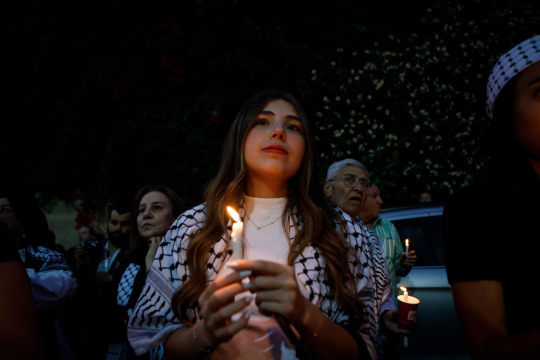

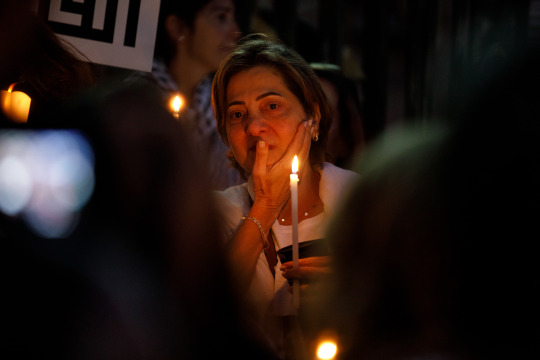
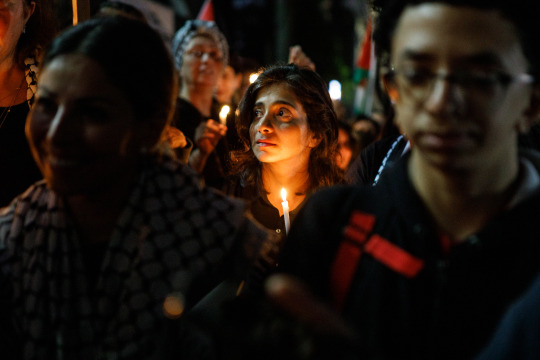
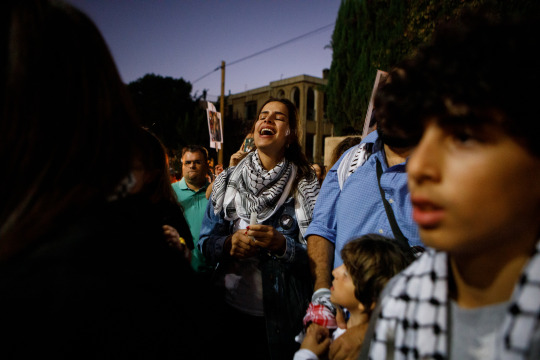
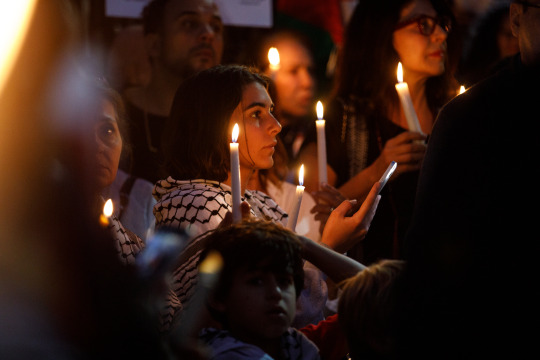


A vigil at the Greek Orthodox Church in Amman in memory of the Palestinian victims in Gaza, children, men, and women who lost their lives as a result of the Israeli airstrikes targeting hospitals, schools, mosques, churches, and entire neighborhoods.
-
To see more of these images go to my website
https://www.anniesakkab.com/bloomberg-pro-palestinian-jordan-demonstrations
#Jordan#Demonstration#Palestine#Gaza#Photography#Pro-Palestine#protests#war#christians#Greek#Orthodox#church
54 notes
·
View notes
Text
‘We won’t stop’: How Columbia’s students etched a new Gaza protest legacy
Inside a movement that took over a university building and lost its encampment within 24 hours – yet refuses to die.
New York, United States — At about 10pm on Monday, April 29, I thought I would call it a night.
My student journalist colleagues and I had stayed late into the night on Columbia University’s campus the previous couple of days, reporting on a story that had grabbed the world’s attention: the pro-Palestine protests and encampment that had inspired similar campaigns in schools across the United States and globally.
As I slung my camera bag on my back and began to leave campus, walking by the camp, I got a tip from a passing protester: “I would stick around till about midnight,” they said. “Maybe go home first, though.”
Got it. I went home to charge backup camera batteries and grab spare memory cards before leaving for campus again.
Back at Columbia, it appeared that more than one of us had gotten the tip. Crowds of student journalists, all of us with matching paper badges and blue tape on our clothes, waited next to the encampment for whatever was to come. Our journalism faculty stood by our side, as they had been doing throughout.
Protesters grouped into “platoons”, and while we didn’t know what to expect, we kept eyes on different corners.
We split up to make sure different spots were covered; a few of us stuck by Pulitzer Hall, the home of Columbia Journalism School, where a small number of protesters had convened, while some others stood ready with cameras and recorders by the encampment.
That is when it all began. Campers began walking their tents off the lawn. One group began chanting. Another at the opposite end of the lawn sang protest hymns. I was with a small cohort of journalists who followed the tents to another small lawn, a clever decoy – whether intended or not – that meant many of us missed the moment, at the opposite end of campus, when protesters entered Hamilton Hall.
By the time we had run over, tens of student protesters had gathered to link arms outside the building, which their predecessors had taken over in 1968 to protest against the Vietnam War, and in 1985 to demand that Columbia divest from firms tied to apartheid South Africa.
Two of my colleagues were in the middle of the scrum, up against the doors watching two counter-protesters attempt to stop the occupation before being pushed out. Protesters rushed metal picnic tables, wooden chairs, trash cans, and planters to the doors where they were zip-tied together, effectively forming a barricade.
Two masked individuals appeared from a second-floor balcony to cheers and applause. They unfurled a hand-painted sign, “Hind’s Hall”, a reference to the six-year-old Palestinian girl who was killed with her family in their car in January as they tried to escape Israel’s military assault in Gaza.
That night, I fell asleep on the floor of a sixth-storey classroom in Pulitzer Hall to the echoes of song, one lone voice amplified through a megaphone, coming from Hamilton Hall: “This joy that I have, the world didn’t give it to me … the world can’t take it away.”
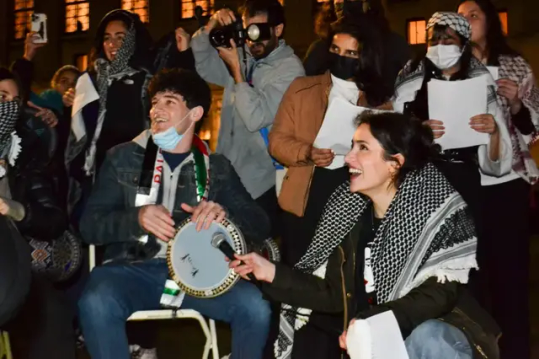
Student protesters playing music at the Columbia University encampment in New York City [Yasmeen Altaji/Al Jazeera]
The final offer
The morning before had felt very different. Columbia University’s South Lawn was packed, and the little protest village in the heart of the campus – dozens of tents and tarps comprising the “Gaza solidarity encampment” – was bustling with life, two weeks since its erection.
The protest is rooted in a decades-long movement for Palestinian rights in their homeland, and to hold Israel accountable for its illegal occupation of Palestinian territories. The current campaign against Israel’s war on Gaza – in which more than 34,000 people have been killed – also aims to pressure Columbia to divest from Israel-linked companies, just as the university did in the case of apartheid South Africa after similar protests four decades ago.
In my time covering the protest, the sounds at the encampment varied. Some days, you could hear the (Islamic) adhan, or the chants of (Jewish) Passover prayer. Or the sounds of the dumbek (drum) and sharp violins echoing microtonal hymns of Palestinian folk music and classical Andalusian muwashshah. Speakers amplified the melodies of iconic musicians like Abdel Halim Hafez and Fairuz.
Protesters shared donated hot meals – pizzas and samosas, bagels and eggs, sacks of mandarins and tubs of crackers, muffins and cookies spread on a tarp aptly called the “cornucopia”.
One camper had set up a makeshift nail parlour, painting red, white, black and green manicures matching the Palestinian flag. Cardboard “street signs” named the tight spaces between rows of tents “Walid Daqqa Road”, after the Palestinian novelist and activist who died of cancer in April, while in Israeli custody.
In the lawn’s centre, organisers routinely updated a whiteboard to reflect the day’s programmed activities: Dhuhr prayer and Shabbat dinner, with jazz in the mix, too.
In a corner of the lawn near the main campus walk, an “art guild” was buzzing with protesters painting signs, drawing patterns of the keffiyeh, decorating and personalising tent spaces.
But that Monday, campers received a final offer from the university administration under President Nemat “Minouche” Shafik: evacuate now, and evade suspension. Campers defied the order.
And by Monday night, the morning’s bustle had died down to a hum, then a whisper, before the eruption that culminated in the takeover of Hamilton Hall. At the encampment site, the zipper flap doors of empty tents billowed in the breeze. Blankets lay crumpled beside pillows still dented from a nap; a sole LED lantern left lit on the ground, a paintbrush crusted with dried red and green acrylic lay stuck on a paper plate.
It’s a community that student journalists like myself at the Columbia Journalism School had closely observed for days at a stretch, unlike the “outside media” who were only allowed on to campus in daily two-hour windows since the encampment went up. Joining us were undergraduate peers at student publications including WKCR and the Columbia Daily Spectator.
A community that, through the intensifying attention on its members, had been trying to emphasise that they weren’t the story. Signs planted across the lawn read: “All eyes on Gaza.”
But in the 24 hours that would follow, the world’s gaze on Columbia would only sharpen.
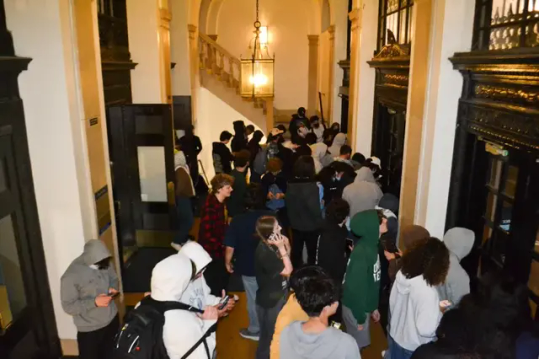
Students were trapped inside the entrance vestibule at John Jay Hall in Columbia University in New York on Tuesday, April 30, 2023 [Yasmeen Altaji/Al Jazeera]
The raid
Tuesday morning started eerily quiet. The camp was empty, save for a few protesters, and Hamilton Hall was sleepy, the only movement coming from a banner reading “INTIFADA” hanging off the side of the building.
Just a few days prior, far before the occupation of Hamilton Hall, the Columbia administration had sent a notice arguing that “to bring back the NYPD at this time would be counterproductive, further inflaming what is happening on campus, and drawing thousands to our doorstep who would threaten our community”.
The note was met with mistrust by protesters: After all, the university had already called the police to campus for the first time in more than 50 years in April to try to clear the encampment. More than 100 students had been arrested.
Instead, I heard organisers advise campers to pack their belongings in trash bags and write phone numbers on their arms in case of arrest.
By Tuesday night, their apprehension would turn into reality. The NYPD entered Columbia’s campus shortly after 9pm on Tuesday (01:00 GMT on Wednesday).
Students linked arms and sang together in anticipation before the harmonies of “We shall not be moved” merged with the march of hundreds of police officers making their way, in formation, to Hamilton Hall.
Calls through long-range acoustic devices (LRAD) to disperse or face arrest, echoed across the campus square, all the time weaving in and out of the floating tunes of the protest hymns, earworms that anyone who’d been on campus had likely come to memorise.
Protesters outside of Hamilton braced for arrest. But officers turned away from them upon arrival, and instead turned towards us – onlookers and press.
Officers instructed us to vacate the area. We walked backwards to get everything on video. “It’s easier if you face forward,” one officer said. “Turn around so you don’t fall,” another yelled repeatedly in a collective command. “Time to go inside,” another said. “Back to your dorms.”
While our backs were against the door of a building at the end of the courtyard where Hamilton was, the doors opened, and officers raised their batons, giving one final push until we were all inside. There was a moment of disorientation before we realised where we were: inside an undergraduate dormitory called John Jay Hall.
It’s where the student health centre, a dining hall, and a late-night campus eatery are. But we couldn’t see any of that. While police guarded the doors into the entry vestibule of the building in front of us, campus security guarded the rest of the building behind us, restricting access to dorm residents.
With about 30 or 40 of us squeezed into the small entry vestibule, ventilation was poor. We wouldn’t reach the bathroom. Red arrows pointed towards the emergency exit but the doors were blocked by officers. Phone batteries were dying. And most pressing, for the journalists among us: we couldn’t see Hamilton beyond the bodies of officers standing at John Jay’s glass doors.
For about three hours, students kicked at the front doors, slouched on the ground against the wall, and slept with their backpacks as pillows. One student sat cross-legged on the floor, sobbing softly while her friend comforted her.
Three hours passed in that hall before we were let out, officers directing us to dorms and buildings they did not know the names or locations of. “We know you want to get out of here. We’re doing you a favour,” one said.
As I left campus at about 1:30am, I walked past a crew hauling the tents off the South Lawn and into a garbage truck that crushed them on the spot.
[See embedded video in the article]
The remains
On Wednesday, the tension wasn’t palpable, only disappointment. The campus was quiet, but not calm. It was completely empty. No one, aside from residents and essential staff – which the journalism faculty ensured we were viewed as, as student journalists – were allowed past campus gates.
Where the encampment once stood, there were only marks of discoloured grass in the shape of rectangular tent bases.
But the movement seems anything but a ghost; on Wednesday, protesters hosted a “light show” beside the campus, projecting titles onto the public-facing side of Hamilton Hall that read “Hind’s Hall forever.”
Every year, on the eve of exams, students gather to let out what is known as a “primal scream” on campus. On Thursday, they took that tradition to Shafik’s house, shouting outside her door.
On Friday, protesters again lined the street outside of Columbia’s gate. And the words still rang through the neighbourhood: “Disclose, divest, we will not stop, we will not rest.”
#palestine#free palestine#save palestine#gaza#free gaza#save gaza#israel#israel palestine conflict#israeli apartheid#bds boycott#boycott israel#bds movement#war on gaza#gaza genocide#gaza strip#world news#current events#palestinian genocide#stop the genocide#genocide#columbia university#student activism#activism#demonstration
34 notes
·
View notes
Text

If anyone following this blog still believes that Palestinians are terrorists and that Israel is merely "defending itself", you are more than welcome to leave.
I do not want to believe that people are evil. I've seen ignorance, I've seen misinformed people. But this goes beyond that. Over 30,000 are dead. Gone forever. Lineages wiped out. This is a readily available statistic that most everybody even loosely following the genocide has heard. And yet some are still complacent. Some even push to go further. I have no choice but to believe that people of this opinion are evil down to their core.
As hopeless as it seems, it's not over. Remember the martyrs. Amplify the voices of Palestinian people. Donate what you can. Be loud and proud about your support. Do everything in your power to stop this now.
May Palestine be free, may its people know safety, and may its martyrs know peace.
#free palestine#free gaza#from the river to the sea palestine will be free#banged this out in like 4 days because that zionist demonstration on my campus pissed me the fuck off
24 notes
·
View notes
Text
Canada🇨🇦.
|
#from the river to the sea palestine will be free#gaza strip#palestine#free palestine 🇵🇸#gazaunderattack#gazaunderfire#فلسطين#غزة تحت القصف#طوفان الأقصى#free gaza#غزة تحت النار#gaza under siege#gaza under bombardment#gaza genocide#stop the war on the children of the gaza strip#stop gaza genocide#stop the genocide#ceasefireingazanow#ceasefire in gaza#ceasfire now#ceasefire#fuck israel#there is no safe place in the gaza strip#save the children of gaza#هنا غزة#غزة ١٨٠#180 days of genocidal war waged by Israel against the innocent people of the Gaza Strip#demonstrations for gaza#canada 🇨🇦#all the world stand with gaza
24 notes
·
View notes
Text
🇲🇦🇵🇸 🚨
DEMONSTRATORS MARCH IN SUPPORT OF GAZA IN MOROCCO
📹 Demonstrations in Tangiers, Morocco in support of Palestinians on their 200th day under siege, blockade and bombardment by the Israeli occupation army in the Gaza Strip.
#source
@WorkerSolidarityNews
#morocco#tangiers protest#tangiers#morocco news#gaza protests#palestine protest#protests#demonstrations#palestine#palestine news#solidarity with palestine#palestinians#free palestine#free gaza#end the occupation#politics#news#geopolitics#world news#global news#international news#war#breaking news#israel#current events
100 notes
·
View notes
Text
It's 3am and that means I have to go to bed now, I'll be back when I wake to resume live updates. For now, here is an underreported event in New York, thousands of Pro-Palestinians rallied together today to march and show their solidarity.

BASED NEW YORK
✊🇵🇸
Source: @Sprinter99800 on Twitter
For continuous updates while I'm gone, click the link below:
#free gaza#gaza strip#irish solidarity with palestine#free palestine#palestine#gaza#news on gaza#al jazeera#boycott israel#israel#New York#American Solidarity with Palestine#Goodnight#Protest#Demonstration#USA
663 notes
·
View notes
Text
Zionist Scoundrels

“Anti-Semitism Is The Last Refuge Of The Zionist Scoundrel.”
#art#gaza#palestine#palestinians#free palestine#islam#islamophobia#israel#anti zionisim#zionistterror#zionazis#zionistcensorship#zionsim is terrorism#war crimes#war criminals#crimes against humanity#crimes against children#crimes against women#protest#demonstration#demonstrators#demonstrates#activism#protests#direct action#peaceful protest#protesting#civil rights#iof terrorism#youtube
43 notes
·
View notes
Text
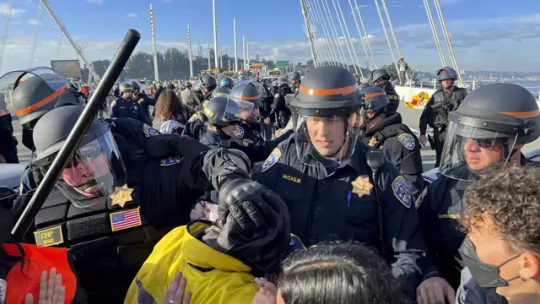


#protest#demonstration#war crime#genocide#apartheid#gaza#palestine#police state#war#fascism#apec#biden#san francisco#sf#san fran#oakland#california#2023
37 notes
·
View notes